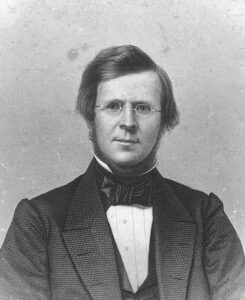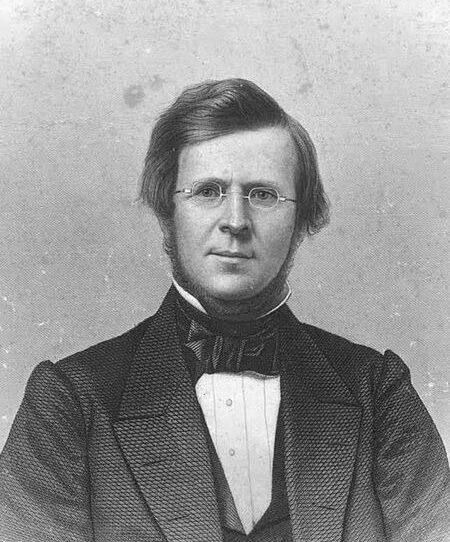Written by Jerrica Blackey, Gordon-Nash Library Director and Archivist.
During the first one hundred years of New Hampton School’s existence, we were committed to “saving souls” by preparing many students for the ministry. After a division in the early 1850s, the school was renamed “The New Hampton Literary and Biblical Institution,” and a theological school imported from Whitestown, New York, brought students and teachers to strengthen the religious program. For the next sixteen years, it remained at New Hampton, as influential people nourished their roots here, supporting all men and women, not just “true believers.” Today New Hampton School continues to support diversity, equity, and inclusion, although with perspectives that have altered over time.
One example of a champion for all was Oren B. Cheney (1816-1903) of Holderness, New Hampshire. In 1829, at age 13, Oren was injured while working on his father’s farm, and the family decided to send him to New Hampton to board, as the teachings of the Free-will Baptists who ran the school were in harmony with those of the Cheney family. During that first year, Oren was inspired by a student teacher, Hosea Quimby. At some point after Quimby left to found the Parsonfield Seminary in Maine, Oren followed. It was too far to travel, however, so he returned to New Hampton School to graduate in 1835. He was a member of one of New Hampton’s literary societies, the Social Fraternity (the “Fraters”), and remained active throughout his life.
From New Hampton, he matriculated to Brown, whose president, Francis Wayland, was a close friend of New Hampton School founder John K. Simpson. While at Brown, Oren witnessed something that profoundly impacted his outlook on life. Observing a meeting of women committed to antislavery, he saw they were forced by a mob to disband shortly after they assembled. The indignation he felt as he “noted the spirit of the mob made him an out-and-out abolitionist, and from that time he lost no opportunity to do all he could by voice and pen for the emancipation of the slaves.”[1]
Understanding that Dartmouth College was considerably more supportive of the abolition movement than Brown, Cheney transferred to Dartmouth, graduating in 1839. He received a Doctor of Divinity from Wesleyan in 1863.
By this time, Cheney was so touched by helping people obtain freedom he decided to make the ministry his life’s work. He and his wife and child set off to the Whitestown Seminary in New York to learn more and teach a course there, but it was short-lived as his wife took ill, and they returned to New Hampshire, where she died in 1845. There is little doubt that Cheney’s connection to Whitesfield (his sister, an alumna, was a preceptress there) played a role in the theological school moving to New Hampton, as noted above.
Cheney’s connection to human rights can be traced back to his sitting on a stack of papers–The Morning Star–as he traveled to Parsonfield. This fiery abolitionist paper was edited by his father and produced at his paper mill. The family supported the Underground Railroad and was known to shelter slaves from Windy Row to Hancock, New Hampshire, though it was highly illegal to do so under the Fugitive Slave Act.
Having the ties that bind and tenderness with people, Oren Cheney was able to pull some old friends together in the name of antislavery. With the assistance of George G. Fogg, his roommate both at New Hampton and Dartmouth, and Amos Tuck, a Parsonsfield man and family friend, he was able to get separate parties to work together. When the ballots were counted, John P. Hale was in the US Senate, and Amos Tuck was in the House of Representatives. George G. Fogg, a former teacher at New Hampton School, served as the US Minister to Switzerland during the Civil War. Through these coordinated efforts, another anti-slavery senator was elected. Cheney’s father and two brothers were members of the New Hampshire Legislature. His brother, Person, was a Governor of New Hampshire and a US Senator.
Oren Cheney would serve on the board of trustees at New Hampton for many years. His sister Harriott graduated in 1858 and taught at New Hampton School for two years. Many other family members attended the school too. Most famously, though, after finding his first job as a pastor in Lebanon, Maine, he was the founder and first president of the Maine State College, which later became Bates College.
In November of 1899, Arthur Smith 1901 did a profile on Cheney in The Hamptonia saying, “It is therefore a ‘Frater’ who has the honor of founding Bates College and who, as its president, in 1859, conferred the first degree given by a New England college to a woman.” Oren B. Cheney is, indeed, a shining example of the legacy kept by New Hampton School.
Jerrica Blackey,
Library Director & Archivist
March 30, 2023
[1] Cheney, Emeline Burlingame-Cheney. The Story of the Life and Work of Oren B. Cheney. Morning Star Publishing House, 1907.




